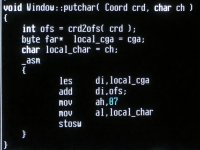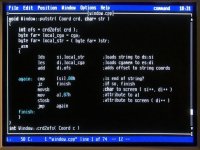Idea for combining top view (roguelike type) and grid based first person rpg (ala Wizardry) in text mode. The target is an 8088/86 based PC with a CGA card.
First try in vintage c ++ (Open Watcom) and pdcurses.
Video from test (music unfortunately not mine):
On 386 and VGA it works fine, but on my 5155 it's very slow. The program logic itself works quickly so the problem is probably in display. My guess is pdcurses uses the BIOS functions to display characters in this case.
That’s why I'm going to get rid of pdcurses and display it directly to screen memory and use int16h for the keyboard.
If someone would like to look at the current code and comment or advise something, I would be grateful.
https://github.com/goostaw/pseudo3d_ascii/tree/master
Since I'm just learning, I will probably have a few questions for more experienced forum users.
I hope you will help.
First try in vintage c ++ (Open Watcom) and pdcurses.
Video from test (music unfortunately not mine):
On 386 and VGA it works fine, but on my 5155 it's very slow. The program logic itself works quickly so the problem is probably in display. My guess is pdcurses uses the BIOS functions to display characters in this case.
That’s why I'm going to get rid of pdcurses and display it directly to screen memory and use int16h for the keyboard.
If someone would like to look at the current code and comment or advise something, I would be grateful.
https://github.com/goostaw/pseudo3d_ascii/tree/master
Since I'm just learning, I will probably have a few questions for more experienced forum users.
I hope you will help.


